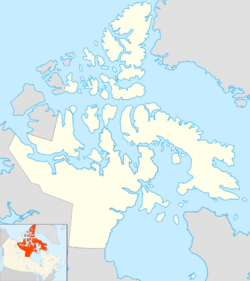Tahiryuaq facts for kids
Quick facts for kids Tahiryuaq |
|
|---|---|
| Ferguson Lake | |
| Location | southern Victoria Island, Kitikmeot Region, Nunavut |
| Coordinates | 69°25′16″N 105°16′03″W / 69.42111°N 105.26750°W |
| Primary outflows | Ekalluk River |
| Basin countries | Canada |
| Surface area | 588 km2 (227 sq mi) |
| Surface elevation | 11 m (36 ft) |
| Islands | 8 km × 4 km (5.0 mi × 2.5 mi) |
| Settlements | Cambridge Bay, 50 km (31 mi) south |
Tahiryuaq, also known as Ferguson Lake, is a large lake in northern Canada. It's found on the southern part of Victoria Island in the Kitikmeot Region of Nunavut. The lake's name in Inuinnaqtun is Tahikyoak.
The water from Tahiryuaq flows west into a part of the Ekalluk River called Iqaluktuuq. This name means "place of big fish." The river then flows into Wellington Bay and eventually reaches the Arctic Ocean. The lake used to be called Ferguson Lake, named after a police officer from the Royal Canadian Mounted Police. However, it is now known by its original and traditional name, Tahiryuaq.
Contents
Nature Around Tahiryuaq
The area around Tahiryuaq is often called a "polar semi-desert." This means it's a very cold and dry place, but it still has different types of plants and animals that are used to this environment.
Plants and Landscape
Even though it's a cold place, you can find various plants around Tahiryuaq. These include:
- Willow-sedge meadows: These are wet, grassy areas with small willow bushes and sedge plants.
- Dryas uplands: These are higher, drier areas where a tough plant called dryas grows.
- Raised beaches: These are old shorelines that are now higher than the current water level.
Animals of the Region
Tahiryuaq is home to many interesting animals that have adapted to the Arctic climate.
Caribou and Other Mammals
A special group of caribou called the Dolphin-Union caribou herd migrates through the narrow land between Wellington Bay and Tahiryuaq. This area acts like a funnel, making it easier for Inuit hunters to find them. Other animals you might see here include:
- Muskox: Large, shaggy animals known for their thick fur.
- Arctic hare: Rabbits with white fur that helps them blend in with the snow.
Birds and Fish
The area also has birds like the ptarmigan, a bird that changes its feather color with the seasons. The lake itself is full of fish, which are an important food source. These include:
- Arctic char (called iqalukpiit by the Inuit)
- Lake trout (called ihuurayuit by the Inuit)
History and People
For a very long time, the Tahiryuaq area has been important to people living in the Arctic.
Ancient Cultures
Archaeological sites around the lake and its river show that different groups of people lived here over thousands of years.
- The Dorset culture people lived here first.
- Later, the Thule people arrived. They were the ancestors of today's Inuit.
- These ancient people relied on the lake's fish, like Arctic char and lake trout, as their main food.
Inuit Hunters
The Copper Inuit people, who are part of the larger Inuit group, have lived in this area for a long time. They were skilled hunters and used the land and animals around Tahiryuaq for survival. The caribou migrating through the narrow land near the lake were a key part of their diet.


